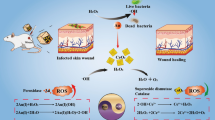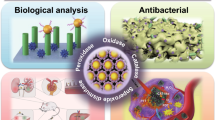Abstract
Oxidative stress is associated with many acute and chronic inflammatory diseases. Development of nanomaterial-based enzyme mimetics for reactive oxygen species (ROS) scavenging is challenging, but holds great promise for the treatment of inflammatory diseases. Herein, we report the highly ordered manganese dioxide encapsulated selenium-melanin (Se@Me@MnO2) nanozyme with high efficiency for intracellular antioxidation and anti-inflammation. The Se@Me@MnO2 nanozyme is sequentially fabricated through the radical polymerization and the in-situ oxidation-reduction. In vitro experimental results demonstrated that the Se@Me@MnO2 nanozyme exhibits multiple enzyme activities to scavenge ROS, including catalase (CAT), glutathione peroxidase (GPx) and superoxide dismutase (SOD). Mechanism researches illustrated that the Se core possesses GPx-like catalytic activity, the Me and the MnO2 possess both the SOD-like and the CAT-like activities. What’s more, due to the stable unpaired electrons existing in the nanozyme, the Se, Me and MnO2 provide synergistic and fast electron transfer effect to achieve the quickly scavenging of hydrogen peroxide, hydroxyl radical, and superoxide anion. Further in vivo experimental results showed that this biocompatible nanozyme exhibits cytoprotective effects by resisting ROS-mediated damage, thereby alleviating the inflammation. This multienzyme mimetics is believed to be an excellent ROS scavenger and have a good potential in clinical therapy for ROS-related diseases.

Similar content being viewed by others
References
Noubade, R.; Wong, K.; Ota, N.; Rutz, S.; Eidenschenk, C.; Valdez, P. A.; Ding, J. B.; Peng, I.; Sebrell, A.; Caplazi, P. et al. NRROS negatively regulates reactive oxygen species during host defence and autoimmunity. Nature 2014, 509, 235–239.
Yang, B. W.; Chen, Y.; Shi, J. L. Reactive oxygen species (ROS)-based nanomedicine. Chem. Rev. 2019, 119, 4881–4985.
Gao, S. S.; Lin, H.; Zhang, H. X.; Yao, H. L.; Chen, Y.; Shi, J. L. Nanocatalytic tumor therapy by biomimetic dual inorganic nanozyme-catalyzed cascade reaction. Adv. Sci. 2019, 6, 1801733.
Wang, Z. Z.; Zhang, Y.; Ju, E. G.; Liu, Z.; Cao, F. F.; Chen, Z. W.; Ren, J. S.; Qu, X. G. Biomimetic nanoflowers by self-assembly of nanozymes to induce intracellular oxidative damage against hypoxic tumors. Nat. Commun. 2018, 9, 3334.
Tong, L. Y.; Chuang, C. C.; Wu, S. Y.; Zuo, L. Reactive oxygen species in redox cancer therapy. Cancer Lett. 2015, 367, 18–25.
Panieri, E.; Santoro, M. M. ROS homeostasis and metabolism: A dangerous liason in cancer cells. Cell Death. Dis. 2016, 7, e2253.
Chouchani, E. T.; Kazak, L.; Jedrychowski, M. P.; Lu, G. Z.; Erickson, B. K.; Szpyt, J.; Pierce, K. A.; Laznik-Bogoslavski, D.; Vetrivelan, R.; Clish, C. B. et al. Mitochondrial ROS regulate thermogenic energy expenditure and sulfenylation of UCP1. Nature 2016, 532, 112–116.
Zhao, Z. H.; Wang, W. Q.; Li, C. X.; Zhang, Y. Q.; Yu, T. R.; Wu, R. F.; Zhao, J. Y.; Liu, Z.; Liu, J.; Yu, H. J. Reactive oxygen species-activatable liposomes regulating hypoxic tumor microenvironment for synergistic photo/chemodynamic therapies. Adv. Funct. Mater. 2019, 29, 1905013.
Houstis, N.; Rosen, E. D.; Lander, E. S. Reactive oxygen species have a causal role in multiple forms of insulin resistance. Nature 2006, 440, 944–948.
Finkel, T.; Holbrook, N. J. Oxidants, oxidative stress and the biology of ageing. Nature 2000, 408, 239–247.
Allen, C. L.; Bayraktutan, U. Oxidative stress and its role in the pathogenesis of ischaemic stroke. Int. J. Stroke 2009, 4, 461–470.
Xu, X. D.; Saw, P. E.; Tao, W.; Li, Y. J.; Ji, X. Y.; Bhasin, S.; Liu, Y. L.; Ayyash, D.; Rasmussen, J.; Huo, M. et al. ROS-responsive polyprodrug nanoparticles for triggered drug delivery and effective cancer therapy. Adv. Mater. 2017, 29, 1700141.
Bian, P. X.; Zhang, J. X.; Wang, J. Y.; Yang, J.; Wang, J. Y.; Liu, H. L.; Sun, Y. M.; Li, M. X.; Zhang, X. D. Enhanced catalysis of ultrasmall Au-MoS2 clusters against reactive oxygen species for radiation protection. Sci. Bull. 2018, 63, 925–934.
Imlay, J. A.; Linn, S. DNA damage and oxygen radical toxicity. Science 1988, 240, 1302–1309.
Diehn, M.; Cho, R. W.; Lobo, N. A.; Kalisky, T.; Dorie, M. J.; Kulp, A. N.; Qian, D. L.; Lam, J. S.; Ailles, L. E.; Wong, M. et al. Association of reactive oxygen species levels and radioresistance in cancer stem cells. Nature 2009, 458, 780–783.
Nathan, C.; Cunningham-Bussel, A. Beyond oxidative stress: An immunologist’s guide to reactive oxygen species. Nat. Rev. Immunol. 2013, 13, 349–361.
Puente, B. N.; Kimura, W.; Muralidhar, S. A.; Moon, J.; Amatruda, J. F.; Phelps, K. L.; Grinsfelder, D.; Rothermel, B. A.; Chen, R.; Garcia, J. A. et al. The oxygen-rich postnatal environment induces cardiomyocyte cell-cycle arrest through DNA damage response. Cell 2014, 157, 565–579.
Roth, T. L.; Nayak, D.; Atanasijevic, T.; Koretsky, A. P.; Latour, L. L.; McGavern, D. B. Transcranial amelioration of inflammation and cell death after brain injury. Nature 2014, 505, 223–228.
Liu, T. F.; Xiao, B. W.; Xiang, F.; Tan, J. L.; Chen, Z.; Zhang, X. R.; Wu, C. Z.; Mao, Z. W.; Luo, G. X.; Chen, X. Y. et al. Ultrasmall copper-based nanoparticles for reactive oxygen species scavenging and alleviation of inflammation related diseases. Nat. Commun. 2020, 11, 2788.
Wu, J. J. X.; Wang, X. Y.; Wang, Q.; Lou, Z. P.; Li, S. R.; Zhu, Y. Y.; Qin, L.; Wei, H. Nanomaterials with enzyme-like characteristics (nanozymes): Next-generation artificial enzymes (II). Chem. Soc. Rev. 2019, 48, 1004–1076.
Liu, Y. L.; Shi, J. J. Antioxidative nanomaterials and biomedical applications. Nano Today 2019, 27, 146–177.
Zhu, X.; Radovic-Moreno, A. F.; Wu, J.; Langer, R.; Shi, J. J. Nanomedicine in the management of microbial infection-overview and perspectives. Nano Today 2014, 9, 478–498.
Liu, X. L.; Pan, Y. C.; Yang, J. J.; Gao, Y. F.; Huang, T.; Luan, X. W.; Wang, Y. Z.; Song, Y. J. Gold nanoparticles doped metal-organic frameworks as near-infrared light-enhanced cascade nanozyme against hypoxic tumors. Nano Res. 2020, 13, 653–660.
Kim, C. K.; Kim, T.; Choi, I. Y.; Soh, M.; Kim, D.; Kim, Y. J.; Jang, H.; Yang, H. S.; Kim, J. Y.; Park, H. K. et al. Ceria nanoparticles that can protect against ischemic stroke. Angew. Chem., Int. Ed. 2012, 51, 11039–11043.
Li, Y. Y.; He, X.; Yin, J. J.; Ma, Y. H.; Zhang, P.; Li, J. Y.; Ding, Y. Y.; Zhang, J.; Zhao, Y. L.; Chai, Z. F. et al. Acquired superoxide-scavenging ability of ceria nanoparticles. Angew. Chem., Int. Ed. 2015, 54, 1832–1835.
Soh, M.; Kang, D. W.; Jeong, H. G.; Kim, D.; Kim, D. Y.; Yang, W.; Song, C.; Baik, S.; Choi, I. Y.; Ki, S. K. et al. Ceria-zirconia nanoparticles as an enhanced multi-antioxidant for sepsis treatment. Angew. Chem., Int. Ed. 2017, 56, 11399–11403.
Gao, Z. Y.; Horiguchi, Y.; Nakai, K.; Matsumura, A.; Suzuki, M.; Ono, K.; Nagasaki, Y. Use of boron cluster-containing redox nanoparticles with ROS scavenging ability in boron neutron capture therapy to achieve high therapeutic efficiency and low adverse effects. Biomaterials 2016, 104, 201–212.
Panzella, L.; Gentile, G.; D’Errico, G.; Della Vecchia, N. F.; Errico, M. E.; Napolitano, A.; Carfagna, C.; d’Ischia, M. Atypical structural and π-electron features of a melanin polymer that lead to superior free-radical-scavenging properties. Angew. Chem., Int. Ed. 2013, 52, 12684–12687.
Liu, Y.; Xiang, Y. P.; Zhen, Y. L.; Guo, R. Halide ion-induced switching of gold nanozyme activity based on Au-X interactions. Langmuir 2017, 33, 6372–6381.
Bao, X. F.; Zhao, J. H.; Sun, J.; Hu, M.; Yang, X. R. Polydopamine nanoparticles as efficient scavengers for reactive oxygen species in periodontal disease. ACS Nano 2018, 12, 8882–8892.
Lunov, O.; Syrovets, T.; Loos, C.; Nienhaus, G. U.; Mailänder, V.; Landfester, K.; Rouis, M.; Simmet, T. Amino-functionalized polystyrene nanoparticles activate the NLRP3 inflammasome in human macrophages. ACS Nano 2011, 5, 9648–9657.
Li, F.; Li, T. Y.; Sun, C. X.; Xia, J. H.; Jiao, Y.; Xu, H. P. Selenium-doped carbon quantum dots for free-radical scavenging. Angew. Chem., Int. Ed. 2017, 56, 9910–9914.
Sun, H. J.; Zhou, Y.; Ren, J. S.; Qu, X. G. Carbon nanozymes: Enzymatic properties, catalytic mechanism, and applications. Angew. Chem., Int. Ed. 2018, 57, 9224–9237.
Huang, Y. Y.; Ren, J. S.; Qu, X. G. Nanozymes: Classification, catalytic mechanisms, activity regulation, and applications. Chem. Rev. 2019, 119, 4357–4412.
Zhang, J. Y.; Wu, S. H.; Ma, L. Z.; Wu, P.; Liu, J. W. Graphene oxide as a photocatalytic nuclease mimicking nanozyme for DNA cleavage. Nano Res. 2020, 13, 455–460.
Vernekar, A. A.; Sinha, D.; Srivastava, S.; Paramasivam, P. U.; D’Silva, P.; Mugesh, G. An antioxidant nanozyme that uncovers the cytoprotective potential of vanadia nanowires. Nat. Commun. 2014, 5, 5301.
Zhang, W.; Hu, S. L.; Yin, J. J.; He, W. W.; Lu, W.; Ma, M.; Gu, N.; Zhang, Y. Prussian blue nanoparticles as multienzyme mimetics and reactive oxygen species scavengers. J. Am. Chem. Soc. 2016, 138, 5860–5865.
Lin, S. C.; Cheng, Y.; Zhang, H.; Wang, X. Y.; Zhang, Y. Y.; Zhang, Y. J.; Miao, L. Y.; Zhao, X. Z.; Wei, H. Copper tannic acid coordination nanosheet: A potent nanozyme for scavenging ROS from cigarette smoke. Small 2020, 15, 1902123.
Li, W.; Liu, Z.; Liu, C. Q.; Guan, Y. J.; Ren, J. S.; Qu, X. G. Manganese dioxide nanozymes as responsive cytoprotective shells for individual living cell encapsulation. Angew. Chem., Int. Ed. 2017, 56, 13661–13665.
Yao, J.; Cheng, Y.; Zhou, M.; Zhao, S.; Lin, S. C.; Wang, X. Y.; Wu, J. J. X.; Li, S. R.; Wei, H. ROS scavenging Mn3O4 nanozymes for in vivo anti-inflammation. Chem. Sci. 2018, 9, 2927–2933.
Xin, Q.; Jia, X. R.; Nawaz, A.; Xie, W. J.; Li, L. T.; Gong, J. R. Mimicking peroxidase active site microenvironment by functionalized graphene quantum dots. Nano Res. 2020, 13, 1427–1433.
Lian, M. L.; Xue, Z. J.; Qiao, X. Z.; Liu, C.; Zhang, S.; Li, X.; Huang, C. H.; Song, Q.; Yang, W. S.; Chen, X. et al. Movable hollow nanoparticles as reactive oxygen scavengers. Chem 2019, 5, 2378–2387.
Huang, Y. Y.; Liu, Z.; Liu, C. Q.; Ju, E. G.; Zhang, Y.; Ren, J. S.; Qu, X. G. Self-assembly of multi-nanozymes to mimic an intracellular antioxidant defense system. Angew. Chem., Int. Ed. 2016, 55, 6646–6650.
Wang, H.; Wan, K. W.; Shi, X. H. Recent advances in nanozyme research. Adv. Mater. 2019, 31, 1805368.
Huang, L.; Chen, J. X.; Gan, L. F.; Wang, J.; Dong, S. J. Single-atom nanozymes. Sci. Adv. 2019, 5, eaav5490.
Ai, Y. J.; Hu, Z. N.; Liu, L.; Zhou, J. J.; Long, Y.; Li, J. F.; Ding, M. Y.; Sun, H. B.; Liang, Q. L. Magnetically hollow Pt nanocages with ultrathin walls as a highly integrated nanoreactor for catalytic transfer hydrogenation reaction. Adv. Sci. 2019, 6, 1802132.
Yang, S. W.; Sun, J.; He, P.; Deng, X. X.; Wang, Z. Y.; Hu, C. Y.; Ding, G. Q.; Xie, X. M. Selenium doped graphene quantum dots as an ultrasensitive redox fluorescent switch. Chem. Mater. 2015, 27, 2004–2011.
Zhu, S.; Zhou, H.; Hibino, M.; Honma, I.; Ichihara, M. Synthesis of MnO2 nanoparticles confined in ordered mesoporous carbon using a sonochemical method. Adv. Funct. Mater. 2005, 15, 381–386.
Zhu, W. W.; Dong, Z. L.; Fu, T. T.; Liu, J. J.; Chen, Q.; Li, Y. G.; Zhu, R.; Xu, L. G.; Liu, Z. Modulation of hypoxia in solid tumor microenvironment with MnO2 nanoparticles to enhance photo-dynamic therapy. Adv. Funct. Mater. 2016, 26, 5490–5498.
Chen, Q.; Feng, L. Z.; Liu, J. J.; Zhu, W. W.; Dong, Z. L.; Wu, Y. F.; Liu, Z. Intelligent albumin-MnO2 nanoparticles as pH-/H2O2-responsive dissociable nanocarriers to modulate tumor hypoxia for effective combination therapy. Adv. Mater. 2016, 28, 7129–7136.
Acknowledgements
This work was supported by the Innovation Zone Project (No. 18-163-12-ZT-003-077-01), Health Major Project (Nos. BWS17J028 and AWS16J018) and National Natural Science Foundation of China (Nos. 81872835, 21621003, and 21563010).
Author information
Authors and Affiliations
Corresponding author
Electronic Supplementary Material
Rights and permissions
About this article
Cite this article
Ai, Y., You, J., Gao, J. et al. Multi-shell nanocomposites based multienzyme mimetics for efficient intracellular antioxidation. Nano Res. 14, 2644–2653 (2021). https://doi.org/10.1007/s12274-020-3267-x
Received:
Revised:
Accepted:
Published:
Issue Date:
DOI: https://doi.org/10.1007/s12274-020-3267-x




